The chameleons of the Standard Model: neutrinos in a nutshell
Neutrinos are the less standard of the particles of the Standard Model of particle physics. I recently discussed shortly the physics behind them, and in particular, I focused on the potential of the future neutrino experiments (see here).

[image credits: Fermilab]
One of the commenters of this post kindly asked me for more detailed information, so that I decided to write down this post.
I will provide below more details on how neutrinos have been introduced, discovered, and why they can be seen as chameleons (as illustrated on the picture on the right).
In short, I will detail why neutrinos are the most intriguing of all elementary particles.
RADIOACTIVE BETA DECAYS
Neutrinos appeared at the beginning of the 20th century as dark particles playing a big role in radioactivity. Physicists where studying reactions where one given atomic nucleus X was transformed into another nucleus Y plus an electron (see the image below).
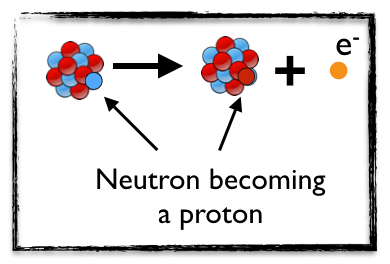
[image credits: homemade]
The initial nucleus X contains a bunch of protons, in red (their number being usually noted Z, that is the atomic number) and a bunch of neutrons (N), in blue.
In the reaction, one of the neutrons is converted into one proton and one electron (in orange), so that the final nucleus Y contains Z+1 protons and N-1 neutrons.
This is a radioactive beta decay, or at least how it was thought to be 100 years ago.
INTRODUCING NEUTRINOS TO SAVE ENERGY CONSERVATION
Using conservation laws, it is a very simple exercise to compute the kinetic energy of the electron (that I note Ee), that is equal to the difference between the parent and daughter nuclear masses (that I note Q).
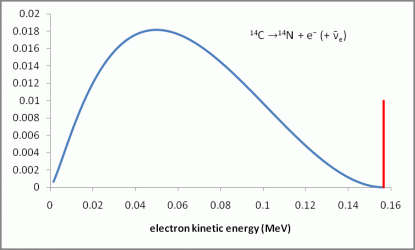
[image credits: the T2K experiment]
This is illustrated on the picture on the right, where the kinetic energy of the electron is represented. In red, the theoretical result that simply reads Ee = Q. In blue, the observation.
The electron energy spectrum is not made of a single value, but is continuous with an end point at Ee = Q.
This was considered as an apparent violation of energy conservation at that time.
The remedy came from Pauli in the 1930ies: he proposed that there was actually a third final-state object into the game, an invisible guy that is light and that escapes any experiment undetected.
Energy conservation hence works again. It is the sum of the electron and the neutrino energies that now equals the difference between the parent and daughter nuclear masses Q. As a consequence, Ee can range from 0 to Q.
THE THEORY STRIKES BACK
Fermi was the first to take the idea of Pauli seriously. As a reward, the dark invisible particle of Pauli has an Italian-like name, as an honor to Fermi: neutrino (noted νe).
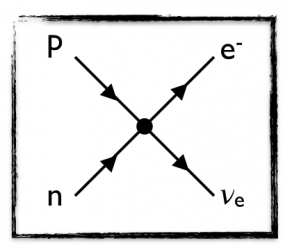
[image credits: homemade]
Fermi modeled the reaction in which a mother neutron decays into a daughter proton, an electron and a neutrino, as illustrated by the Feynman diagram on the left.
By messing up which particle is final and which one is initial, this also dictates how neutrinos interact with matter.
The rate of the corresponding processes is extremely slow, and one can for instance calculate that a neutrino has a mean free path of thousands of light-years in water!
However, a couple of reactions per day can be obtained, if the related detectors are of the ton-scale. Although this looks crazy, this worked like a charm, and a full set of neutrino physics experiments have been successfully designed and run since then.
THREE FAMILIES OF NEUTRINOS
So far, we have connected a neutrino to an electron, but the story does not end there. Other particles resembling a lot to an electron have been found long ago: the muon and the tau. Both of these can be seen as heavier copies of the electrons.
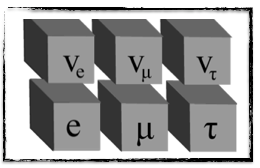
[image credits: homemade]
Similarly, other types neutrinos were discovered too, and the associated particle content is summarized in the picture on the right.
The symbols of the electron, the muon and the tau are respectively e, μ and τ, and the accompanying neutrinos are noted with the symbol ν with an index reflecting their electronic, muonic or tau flavor.
We hence have three flavor of neutrinos, which is what is included in the Standard Model of particle physics.
THE NEUTRINO MASS ISSUE
The Standard Model of particle physics is constructed on symmetries (that is its beauty after all), and those symmetries, together with data to constrain the form of the interactions, impose that neutrinos are massless.
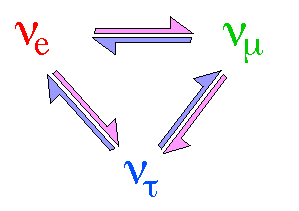
[image credits: Fermilab]
However, two decades of experiments have demonstrated that neutrinos are not that standard…
They are massive, which implies they oscillate: a neutrino of a given type can turn into a neutrino of another time when it propagates or interacts.
This is why I used this chameleon picture at the beginning of this post. We can produce an electron neutrino in one place of Earth, and detect it as a muon neutrino a few hundreds of kilometers away.
COLORFUL CHAMELEONS AND NEUTRINO OSCILLATIONS
There are various mechanisms that could explain the neutrino masses, and they all yields new phenomena that have not been observed (yet?). But there is one deep consequence, the three flavors of neutrino mix with each other.

[image credits: Fermilab]
Each neutrino can be seen as a chameleon changing its electronic, muonic or tau nature when it travels.
Let us assign colors to flavors: the electronic nature of the neutrino is red, the muonic one is blue and the tau one is yellow.
And now comes the complicated part: a neutrino actually contains each flavor in a given amount. As represented with the chameleons on the picture that are more or less red, blue and yellow.
When we observe a neutrino, we get in the detector only one of the three flavors with a probability depending on the flavor content of the neutrino (or the amount of the corresponding flavor it initially had.
This picture explains the observation very well, and current experiments are now trying to measure the physical parameters behind it with some precision.
TAKE-HOME MESSAGE AND REFERENCES
In this post, I extended the discussion on the physics of the neutrino world. I detailed how neutrinos were first introduced by Pauli to describe radioactive beta decays and then modeled by theorists. I finally come with the problematics of the neutrino masses and their oscillations.
I hope neutrino physics is now slightly clearer. Please let me know in the comments.
More information on neutrinos can be found:
- in the Particle Data Group review and there;
- in these CERN lecture notes.
For more discussion on this topic (or anything related to science), please join us on #steemSTEM. The steemSTEM project is a community-supported project aiming to increase the quality and the visibility of STEM (STEM is the acronym for Science, Technology, Engineering and Mathematics) articles on Steemit. You can also follow our curation trail on Streemian to support us.
Very good topic
I don't like chemistry but I read this article that it's interesting
Followed ♥
Why chemistry? I talk about physics :D
Dear @lemouth I'm young and I don't know enough information to distinguish between chemistry and physics
No problem. I was just slightly chocked because there were twice the same comment about chemistry in 4 minutes :p
The difference is a matter of what are the building blocks we are trying to play with. Elementary particles belongs to physics, whilst atoms and molecules to chemistry (although atomic physics exists too) :) The boundary is not that clear, as you can see. But what I am talking about definitely enters physics.
Thank you very much for the clarification
My pleasure!
Can you help me by read my articles and if you liked it you can upvote
Really nicely explained.
I am just curious to ask a question on the T2K experiment. The energy spectrum of the electron is continuous.
Thanks!
I am not talking about T2K itself. I have just borrowed the image from there (which can also be found in many places over the web). But yes, the energy spectrum of the electron is continuous.
What is exactly the question by the way (I am not sure :p)?
Opus, I am so sorry that I accidentally submit the comment with my phone without finish my whole paragraph. I thought the submission was cancelled so I resubmit my question again a few minutes later. Apology for causing a mess
Let me put my question here again for convenience:
The energy spectrum of electron is continuous. As the total energy is a fixed point, so does it mean that the spectrum of neutrino is also a continuous spectrum?
Actually it wont be too suprising to have people saying this is chemistry stuff XD I guess things like fission is one of the first few topics i came across in chemistry (but also physics). They are really fundamental for the elements on the periodic tables XDD
Physics chemistry biology are always tightly connected, and i bet you will say maths too haha
Really nicely explained.
I am just curious to ask a question on the T2K experiment diagram. The energy spectrum of electron is continuous. As the total energy is a fixed point, so does it mean that the spectrum of neutrino is also a continuous spectrum?
Actually it wont be too suprising to have people saying this is chemistry stuff XD I guess things like fission is one of the first few topics i came across in chemistry (but also physics). They are really fundamental for the elements on the periodic tables XDD
Physics chemistry biology are always tightly connected, and i bet you will say maths too haha
Totally.
Yep. But at the end of the day, physicists will rule the world... or not :p You are right but I left hints behind: I mentioned particle physics a bit everywhere in the post. ^^
Physics and chemistry are pretty dependent on math, math is a vehicle to express the physics...
I think they are already ruling it . ;)
Had almost forget what neutrinos were, the world inside the atoms is amazing.....thanks for explaining them so simply....
I agree. A theory itself is a mathematical structure explaining wha is going on with a given domain of science.
Particle physics is not my strength. Can you explain this idea to me: They are massive, which implies they oscillate: a neutrino of a given type can turn into a neutrino of another time when it propagates or interacts.
I don't get the connection between a particle having mass and oscillating.
This comes from the calculations themselves and is not trivial to explain in layman's terms. If one starts computing the oscillation probabilities, one will find that these probabilities are proportional to the mass differences between the neutrinos. Therefore, as oscillations have been observed, neutrinos cannot be all massless.
Time goes you don't "change" and that's really cool! :)
I mean of course you change in some way, but your articles still too scientific for me. :)
I feel real respect for you!
I cannot see myself write on any other topic. But I admit it is often easier to explain things life than with written text :)
Very deep explanation, nice to study radioactive
Oh, great post obout chemistry!
It's okay, I'm joking. :D
Neutrino physics is now slightly clearer really, can be calm. I like it. ;)
Apparently, the chameleons some confused. :D
Chemistryleons? :)
Exactly! :D
The important thing is not to debate the mouth of fellow steemit friends, steemit where people are peaceful.
I didn't get it, sorry...
Chemistry is very hard to learn but to tell a truth is very interesting to learn
I don't know, as I speak about physics :D
Hebat,,